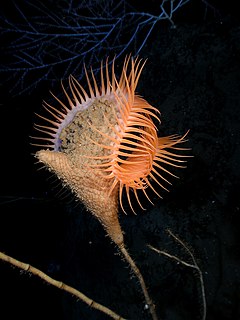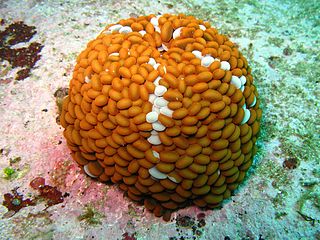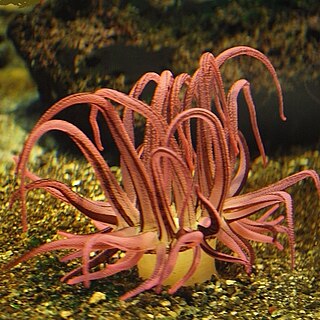External links
- "Pedal disk (invertebrate anatomy) -- Britannica Online Encyclopedia". britannica.com. Retrieved 2009-10-15.
The pedal disc (also known as a basal plate) is the surface opposite to the mouth of the sea anemone. IIt serves to attach the anemone to the substrate, or hard surface, upon which it lives. [1]
The pedal disc is composed of a thin tissue plate and is used by the animal to adhere to and move across the surface. [2]

A polyp in zoology is one of two forms found in the phylum Cnidaria, the other being the medusa. Polyps are roughly cylindrical in shape and elongated at the axis of the vase-shaped body. In solitary polyps, the aboral end is attached to the substrate by means of a disc-like holdfast called a pedal disc, while in colonies of polyps it is connected to other polyps, either directly or indirectly. The oral end contains the mouth, and is surrounded by a circlet of tentacles.

Anthozoa is a class of marine invertebrates which includes the sea anemones, stony corals and soft corals. Adult anthozoans are almost all attached to the seabed, while their larvae can disperse as part of the plankton. The basic unit of the adult is the polyp; this consists of a cylindrical column topped by a disc with a central mouth surrounded by tentacles. Sea anemones are mostly solitary, but the majority of corals are colonial, being formed by the budding of new polyps from an original, founding individual. Colonies are strengthened by calcium carbonate and other materials and take various massive, plate-like, bushy or leafy forms.

The articular disk is a thin, oval plate of fibrocartilage present in several joints which separates synovial cavities. This separation of the cavity space allows for separate movements to occur in each space.
Basal plate may refer to:

The Venus flytrap sea anemone is a large sea anemone that superficially resembles a Venus flytrap. It closes its tentacles to capture prey or to protect itself. It is a deep ocean species.

The articular disk of the temporomandibular joint is a thin, oval plate made of non-vascular fibrous connective tissue located between the mandible's condyloid process and the cranium's mandibular fossa.

Aiptasia is a genus of a symbiotic cnidarian belonging to the class Anthozoa. Aiptasia is a widely distributed genus of temperate and tropical sea anemones of benthic lifestyle typically found living on mangrove roots and hard substrates. These anemones, as well as many other cnidarian species, often contain symbiotic dinoflagellate unicellular algae of the genus Symbiodinium living inside nutritive cells. The symbionts provide food mainly in the form of lipids and sugars produced from photosynthesis to the host while the hosts provides inorganic nutrients and a constant and protective environment to the algae. Species of Aiptasia are relatively weedy anemones able to withstand a relatively wide range of salinities and other water quality conditions. In the case of A. pallida and A. pulchella, their hardiness coupled with their ability to reproduce very quickly and out-compete other species in culture gives these anemones the status of pest from the perspective of coral reef aquarium hobbyists. These very characteristics make them easy to grow in the laboratory and thus they are extensively used as model organisms for scientific study. In this respect, Aiptasia have contributed a significant amount of knowledge regarding cnidarian biology, especially human understanding of cnidarian-algal symbioses, a biological phenomenon crucial to the survival of corals and coral reef ecosystems. The dependence of coral reefs on the health of the symbiosis is dramatically illustrated by the devastating effects experienced by corals due to the loss of algal symbionts in response to environmental stress, a phenomenon known as coral bleaching.

The Davenport Tide Pools are located just past the town of Davenport, California in the United States. They are located off Davenport Landing, which is a street off Highway 1. The tide pools are unique due to the ridges that run up and down the tide pools, allowing for different organisms to live close, even though in a normal habitat they would be unable to do so. The Beach is open sunrise to sunset, and is day use only.

Sea anemones are a group of predatory marine organisms of the order Actiniaria. Because of their colourful appearance, they are named after the anemone, a terrestrial flowering plant. Sea anemones are classified in the phylum Cnidaria, class Anthozoa, subclass Hexacorallia. As cnidarians, sea anemones are related to corals, jellyfish, tube-dwelling anemones, and Hydra. Unlike jellyfish, sea anemones do not have a medusa stage in their life cycle.

Condylactis gigantea is a tropical species of ball anemone that is found in shallow reefs and other shallow inshore areas in the Caribbean Sea – more specifically the West Indies – and the western Atlantic Ocean including southern Florida through the Florida Keys. It is also commonly known as: giant Caribbean sea anemone, giant golden anemone, condylactis anemone, Haitian anemone, pink-tipped anemone, purple-tipped anemone, and Florida condy. This species can easily be seen growing in lagoons or in inner reefs as either individuals or loose groups, but never as colonies. They are often used as a model organism along with others in their genus for facultative symbiosis with monocellular algae.

Stichodactyla helianthus, commonly known as sun anemone, is a sea anemone of the family Stichodactylidae. Helianthus stems from the Greek words ἡλιος, and ἀνθος, meaning flower. S. helianthus is a large, green, sessile, carpet-like sea anemone, from the Caribbean. It lives in shallow areas with mild to strong currents.

Calliactis polypus is a species of sea anemone in the family Hormathiidae. It is usually found living on the surface of a sea snail shell in which a hermit crab is living.

Phlyctenactis tuberculosa, common name the wandering sea anemone or swimming anemone, is a species of sea anemone in the family Actiniidae. It is native to shallow seas around Australia and New Zealand. It was first described by the French zoologist Jean René Constant Quoy and the French naturalist Joseph Paul Gaimard. They were naval surgeons serving in the French Navy and made extensive collections of organisms they came across in their travels.

Actinodendron arboreum, commonly known as tree anemone or hell's fire anemone, is a species of sea anemone in the family Actinodendronidae. It is native to the Indo-Pacific where it grows at depths of down to 28 metres (92 ft). Most sea anemone species are harmless to humans, but A. arboreum is highly venomous and its sting can cause severe skin ulcers.

Dofleinia armata, commonly known as the striped anemone or armed anemone, is a species of sea anemone in the family Actiniidae. It is the only species in the genus Dofleinia.
Aiptasia diaphana, commonly known as the yellow aiptasia or glasrose, is a species of sea anemone native to shallow waters in the temperate eastern Atlantic Ocean and the Mediterranean Sea. It has been introduced into the Red Sea.

The Enthemonae is a suborder of sea anemones in the order Actiniaria. It comprises those sea anemones with typical arrangement of mesenteries for actiniarians.

Gonactinia is a monotypic genus of sea anemones, and G. prolifera is the only species in the genus. It is sometimes called the storey anemone and is found on either side of the northern Atlantic Ocean.

Haloclava producta is a species of sea anemone in the family Haloclavidae, commonly known as the ghost anemone. This species is native to shallow water in the northwestern Atlantic Ocean, between Cape Hatteras and the Bay of Fundy, where it makes a temporary burrow in soft sediment. It is found on sand flats, both intertidally and subtidally.
Isotealia antarctica, the salmon anemone, is a species of sea anemone in the family Actiniidae. It is found in the southern Atlantic and Pacific Oceans and the waters around Antarctica. It is a filter feeder and opportunistic predator.